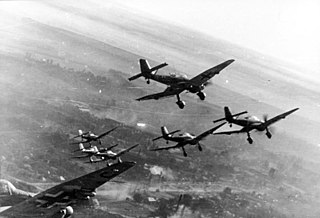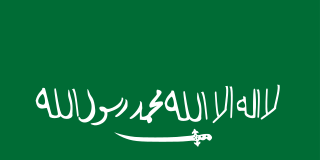Related Research Articles

The history of Saudi Arabia as a nation state began with the emergence of the Al Saud dynasty in central Arabia in 1727 and the subsequent establishment of the Emirate of Diriyah. Pre-Islamic Arabia, the territory that constitutes modern Saudi Arabia, was the site of several ancient cultures and civilizations; the prehistory of Saudi Arabia shows some of the earliest traces of human activity in the world.

World War II or the Second World War was a global conflict that lasted from 1939 to 1945. The vast majority of the world's countries, including all the great powers, fought as part of two opposing military alliances: the Allies and the Axis. Many participating countries invested all available economic, industrial, and scientific capabilities into this total war, blurring the distinction between civilian and military resources. Aircraft played a major role, enabling the strategic bombing of population centres and delivery of the only two nuclear weapons ever used in war. It was by far the deadliest conflict in history, resulting in 70–85 million fatalities. Millions died due to genocides, including the Holocaust, as well as starvation, massacres, and disease. In the wake of Axis defeat, Germany, Austria, and Japan were occupied, and war crime tribunals were conducted against German and Japanese leaders.

Najd is the geographic center of Saudi Arabia, accounting for about a third of the country's modern population. It is the home of the House of Saud, from which they pursued unification with Hejaz under Saudi rule since the time of the Emirate of Diriyah.

Abdulaziz bin Abdul Rahman Al Saud, known in the West as Ibn Saud, was an Arab political and religious leader who founded Saudi Arabia – the third Saudi state – and reigned as its first king from 23 September 1932 until his death in 1953. He had ruled parts of the kingdom since 1902, having previously been Emir, Sultan, and King of Nejd, and King of Hejaz.

The Saudi Arabian National Guard (SANG), also known as the "White Army", is one of the three major branches of the military forces of the Kingdom of Saudi Arabia.

The Ikhwan, commonly known as Ikhwan man ata'a Allah, was a religious militia made up of traditionally nomadic tribesmen which formed a significant military force of the ruler Ibn Saud and played an important role in establishing him as ruler of most of the Arabian Peninsula in the Kingdom of Saudi Arabia.

The Grand Mosque seizure in Saudi Arabia took place between 20 November 1979 and 4 December 1979, when the Grand Mosque of Mecca was besieged by up to 600 militants under the leadership of Juhayman al-Otaybi, a Saudi anti-monarchy Salafi Islamist from the Tribe of Otaibah. They identified themselves as "al-Ikhwan", referring to the religious Arabian militia that had played a significant role in establishing the Saudi state in the early 20th century. As they took hostages from among the worshippers at the holiest Islamic site in the city of Mecca, the Ikhwan called for an uprising against the House of Saud and also declared that the Mahdi had arrived in the form of one of the militants' leaders: Muhammad Abdullah al-Qahtani. Juhayman alleged that the House of Saud had become corrupted, decrying their pursuit of alliances with "Christian infidels" and stating that the Saudi government's policies were betraying Islam by attempting to push secularism into Saudi society. Seeking assistance for their counteroffensive against the Ikhwan, the Saudis requested urgent aid from France, which responded by dispatching advisory units from the GIGN. After French operatives provided them with a special type of tear gas that dulls aggression and obstructs breathing, Saudi troops gassed the interior of the Grand Mosque and forced entry. They successfully secured the site after two weeks of fighting, which culminated in approximately 800 casualties in total.

The Unification of Saudi Arabia was a military and political campaign in which the various tribes, sheikhdoms, city-states, emirates, and kingdoms of most of the central Arabian Peninsula were conquered by the House of Saud, or Al Saud. Unification started in 1902 and continued until 1932, when the Kingdom of Saudi Arabia was proclaimed under the leadership of Abdulaziz, known in the West as Ibn Saud, creating what is sometimes referred to as the Third Saudi State, to differentiate it from the Emirate of Diriyah, the First Saudi State and the Emirate of Nejd, the Second Saudi State, also House of Saud states.
The Battle of Mecca took place on 5 December 1924 in Mecca, as part of the Saudi conquest of the Kingdom of Hejaz by King Abdulaziz Ibn Saud of the Sultanate of Nejd. The Hejaz region was ruled as a kingdom under King Hussein bin Ali of the Hashemite family. The battle in Mecca resulted in a Hashemite defeat to the Saudis and the allied Ikhwan fighters.
Sultan bin Bajad bin Humaid al-'Utaybi was the Sheikh of the Otaibah tribe and one of the prominent leaders of the Ikhwan movement in the Arabian Peninsula. This tribal army supported King Abdulaziz in his efforts to unify Saudi Arabia between 1910 and 1927.
The Battle of Sabilla was the main battle of the Ikhwan Revolt in northern Arabia between the rebellious Ikhwan forces and the army of Abdulaziz al-Saud. It is the last tribal uprising in Arabia. It was also the last major battle in which one side rode camels, as the Ikhwan emphasized radical conservatism and shunned technological modernization.

Ikhwan raids on Transjordan were a series of attacks by the Ikhwan, irregular Arab tribesmen of Najd, on Transjordan between 1922 and 1924. The repeated Wahhabi incursions from Najd into southern parts of his territory were the most serious threat to emir Abdullah's position in Transjordan. The emir was powerless to repel those raids by himself, thus the British maintained a military base, with a small air force, at Marka, close to Amman. The British military force was the primary obstacle against the Ikhwan, helping Emir Abdullah to secure his rule over Transjordan.

The Ikhwan revolt was an uprising in the Arabian Peninsula from 1927 to 1930 led by the Ikhwan. It began in 1927, when the tribesmen of the Otaibah, Mutayr and Ajman rebelled against the authority of Ibn Saud and engaged in cross-border raids into parts of Transjordan, Mandatory Iraq and the Sheikhdom of Kuwait. The relationship between the House of Saud and the Ikhwan deteriorated into an open bloody feud in December 1928. The main instigators of the rebellion were defeated in the Battle of Sabilla, on 29 March 1929. Ikhwan tribesmen and troops loyal to Abdulaziz clashed again in the Jabal Shammar region in August 1929, and Ikhwan tribesmen attacked the Awazim tribe on 5 October 1929. Faisal Al Dawish, the main leader of the rebellion and the Mutair tribe, fled to Kuwait in October 1929 before being detained by the British and handed over to Ibn Saud. Faisal Al-Dawish would die in Riyadh on 3 October 1931 from what appears to have been a heart condition. Government troops had finally suppressed the rebellion on 10 January 1930, when other Ikhwan rebel leaders surrendered to the British. In the aftermath, the Ikhwan leadership was slain, and the remains were eventually incorporated into regular Saudi units. Sultan bin Bajad, one of the three main Ikhwan leaders, was killed in 1931, while Al Dawish died in prison in Riyadh on 3 October 1931.
The Kuwait–Najd War erupted in the aftermath of World War I. The war occurred because Ibn Saud of Najd wanted to annex Kuwait. The sharpened conflict between Kuwait and Najd led to the death of hundreds of Kuwaitis. The war resulted in sporadic border clashes throughout 1919–1920.
The First Saudi–Hashemite War, also known as the First Nejd–Hejaz War or the al-Khurma dispute, took place in 1918–19 between Abdulaziz Ibn Saud of the Emirate of Nejd and Hasa and the Hashemites of the Kingdom of Hejaz.
The Battle of Phoenice took place in 230 BC between the forces of the Epirote League and the Ardiaean Kingdom of Illyria.
Khalid bin Muhammad Al Saud was a member of the Saudi royal family. He was the eldest son of Muhammad bin Abdul Rahman who was the half-brother of King Abdulaziz.

Dhaydan bin Hithlain was one of the leaders of the Ajman tribe and Amir of the hijrah (settlement) of Al Sarrar. His full name was Dhaydan bin Khalid bin Hizam bin Hithlain. Alexei Vassiliev also calls him Zaidan.

The Battle of Turubah was fought on May 26, 1924, between the forces of Hussein bin Ali, under the command of his son Abdullah bin Al-Hussein, and forces under the command of Abdulaziz bin Abdul Rahman Al Saud. It was a larger part of the Hejaz-Nejd War, as well as the Al-Khurma dispute. The battle resulted in the end of Hussein's hopes to expand into the Arabian peninsula, as well as opening the way for Ibn Saud to fortify his own control over the region, which in turn would eventually lead to the creation of Saudi Arabia.

The Declaration of theUnification of Saudi Arabia was officially announced by Prince Faisal bin Abdulaziz, the Viceroy of Hejaz on behalf of King Abdulaziz ibn Saud on September 23, 1932, at 9:00 am from al-Hamidiyah Palace in Mecca. Faisal read out the Royal Decree No. 2716 issued by Abdulaziz ibn Saud on September 18, 1932, that renamed the Kingdom of Hejaz and Nejd and its annexes as the Kingdom of Saudi Arabia.
References
- ↑ Black, Jeremy (2012). Avoiding Armageddon: From the Great War to the Fall of France, 1918-40. United Kingdom: Bloomsbury Publishing. p. 80. ISBN 9781441170521 . Retrieved 26 April 2022.
- ↑ Almana, Mohammed (1982). Arabia Unified: A Portrait of Ibn Saud. United Kingdom: Hutchinson Benham. p. 169. ISBN 9780091472900 . Retrieved 26 April 2022.
- ↑ Burnett, M. Troy (2020). Nationalism Today: Extreme Political Movements Around the World. ABC-CLIO. p. 618. ISBN 9781440850004 . Retrieved 26 April 2022.